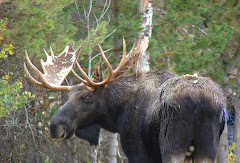
Steelhead yearling and steelhead young of year. They are badly infested with a copepod parasite called "blackspot" - it seems to be related to water temperature and flow conditions. It can weaken or, at levels like this, kill them. Pray to the rain gods for an early onset to winter, please.

Life is like a box of chocolates... you just never know what you're going to get. Like this nearly two-foot-long adult female steelhead. She is an ocean fish, came in with last winter's rains. From the Pacific Ocean she entered via the Golden Gate, smelled her way down to the bottom of the Bay near Milpitas, where Coyote Creek empties into the swampy marshlands in between salt ponds, then fought her way up lower Coyote and into Penitencia Creek, all the way up over several significant drop structures... and maybe, if she was lucky, there was a male already here waiting. Or not... perhaps that was why she stayed, waiting for a male to fertilize the thousands of eggs she'd carried inside her all that distance. She waited too long... and when the rains abruptly stopped in early March and flows dropped, she was trapped in upper Penitencia Creek. She made her way to the deepest, coldest pool she could find, so she could slow her metabolism and wait.... and wait.... and wait. She ate nearly every other fish unlucky enough to be in the pool with her, trying to make it through the summer, all the while losing weight, losing energy, as temperatures warmed and her food supply dwindled. She was so close, so very close... she had only recently died, didn't have a mark on her. RIP girl... so damn sorry we didn't find you in time to help you.
Only about 10 yards upstream in a thicket of tree roots and aquatic plants, the shocker went on, and this flew out into the middle of the stream:

"Ack, WTF? It's a red-legged frog! The last one was reported here in the mid-sixties!" Looks like we've got them again, because this is a subadult female. So typical in this business... get all bummed out and sad by something like that magnificent steelhead we were too late to save, only to be buoyed up by this one. If frogs are expanding their range, that means something is going right. Let's keep it up...
By the way, if you are in the south Bay and want to watch steelhead jumping and maybe even spawning in Alum Rock Park, wait until February or so and head over there after a good hard dump of rain when the creeks are up. Go into the park and drive all the way up to the visitor center. Park and hang out near the bridge that spans the creek. Maybe you'll get lucky. But remember, steelhead are threatened, which means they are protected by state and federal law and it is illegal to handle them or interfere with their activities in any way, unless you have a special permit. So do not approach them or try to catch them. Just sit back and enjoy the show. If you see one in distress and you live in California, call CalTIP at 1 888 DFG-CALTIP (888 334-2258), 24 hours a day, seven days a week. Thanks for helping protect our resources.






 over hill and dale...oops, I mean, through giant culvert and dale....
over hill and dale...oops, I mean, through giant culvert and dale....
 As soon as it's dark enough, on go the waders and headlamps and out come the nets.
As soon as it's dark enough, on go the waders and headlamps and out come the nets. 
 The bullfrogs I've seen here at Coe are the largest I've seen anywhere in the greater SF bay area. They look mutated. These stockponds are so warm and so productive that the normal two-year life cycle of the bullfrog can be completed in only one year, which makes it that much tougher on the red-legs. This big male was almost 9 inches long from the tip of his nose to the vent (urogenital opening). If you stretched him out, he'd have easily been over a foot long from toe to toe. Contrast that with the measurement of the red-leg male, who was about 4-1/2" snout-vent length. Any wonder why bullfrogs are decimating red-legs? Look no further for your evidence.
The bullfrogs I've seen here at Coe are the largest I've seen anywhere in the greater SF bay area. They look mutated. These stockponds are so warm and so productive that the normal two-year life cycle of the bullfrog can be completed in only one year, which makes it that much tougher on the red-legs. This big male was almost 9 inches long from the tip of his nose to the vent (urogenital opening). If you stretched him out, he'd have easily been over a foot long from toe to toe. Contrast that with the measurement of the red-leg male, who was about 4-1/2" snout-vent length. Any wonder why bullfrogs are decimating red-legs? Look no further for your evidence.



